Tag Archive: intervention
January 29, 2015
by Carole Zangari -
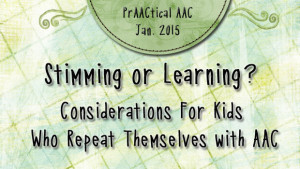
At the CARD 2015 conference earlier this month, I had some great conversations with professionals who wanted to integrate more AAC into their work with beginning communicators. One of the issues that came up was this: What about kids who keep using their AAC to say the same thing over and over? Here are some of the things we discussed. For beginning communicators, repetition is part of exploration. And exploration is part of language learning. Extinguish repetition and we have effectively shut down a tool for language development. Turning off the device, taking it away, or turning the volume controls to silent is NOT an option. (Whew! I can’t tell you how happy I was to hear consensus on that point!) No feeling person would tape the mouth of a speaking child to keep them quiet, and this is the AAC counterpart. Silencing a person by restricting access to their... [Read More...]
Filed under: PrAACtical Thinking
Tagged With: intervention, repetition, silence, stimming
January 12, 2015
by Carole Zangari -
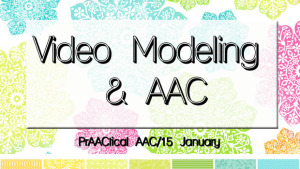
Video modeling is an empirically supported instructional strategy that can help some learners acquire and use a range of new skills. It involves videotaping the expected or desired behavior so that our clients can see, hear, and better understand the skills they are trying to learn. We’ve posted videos about it in the past and know that many of you use it or have considered using it in your clinical practice. Most of the applications have been with speaking children and young adults, but many AAC learners can benefit as well. If you’re thinking of trying out this strategy in your own practice, here are some resources that might be helpful. In a nutshell: Visit the National Center for Professional Development on Autism to review the EBP practice brief on video modeling. Their documents are great for sharing with families and other team members, too. Getting started: Visit Dr. Christine Reeve’s... [Read More...]
Filed under: PrAACtical Thinking
Tagged With: intervention, video modeling, video self modeling
September 8, 2014
by Carole Zangari -
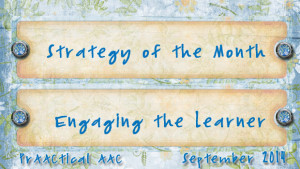
Summer is over in our part of the world and that means we get the opportunity to work with a whole new crop of students and clients. There is so much for beginning clinicians to know about providing AAC services that it is intimidating at best and overwhelming in most cases. In previous posts we’ve written about expectations, goal-setting, intervention strategies, therapy activities, reinforcement, feedback, and the like. This month, we’ll focus on a construct that permeates everything: engagement We all know what it looks and feels like when a client is engaged, but how do we make that happen? Here are some thoughts. 1. Start by presuming that your client is a learner on his/her way to developing competence. Good intervention, consistent language models, the right tools, and plenty of practice will move them along the journey toward improved communication. It’s important that, as clinicians, we truly believe that.... [Read More...]
Filed under: Strategy of the Month
Tagged With: engagement, intervention, presume competence
August 12, 2014
by Carole Zangari -
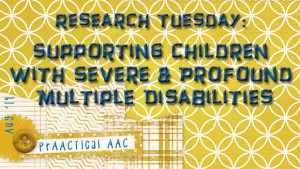
What do we know about the best ways to provide communication support to individuals with severe and profound multiple disabilities (PMLD)? PMLD is a term that generally refers to people who experience profound cognitive limitations in addition to sensory and/or physical disabilities. Many of these individuals have complex medical histories and chronic health concerns. Often, the communication difficulties experienced by individuals with PMLD cause them to be isolated and excluded from many social and educational opportunities. Despite their many challenges, there is evidence to suggest that AAC supports can help these children develop their communication skills. Not much is known, however, about how to structure the AAC intervention to maximize learning. In this study, Harding and her colleagues sought to reduce isolation and promote personal autonomy by providing AAC supports to two children with PMLD. As other researchers have demonstrated the positive impact of AAC on people with PMLD, this... [Read More...]
Filed under: PrAACtical Thinking
Tagged With: Harding, intervention, PMLD, Research Tuesday
July 10, 2014
by Carole Zangari -
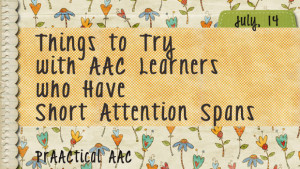
We love talking to AAC practitioners, hearing their stories, and picking up some tips along the way. Some conversations we love for the creative ideas or underlying passion. Others are memorable for less positive reasons. But still, they give us pause and challenge us to be better problem-solvers. “I love those ideas, but they won’t work with MY client: He doesn’t pay attention. He’s just not ready for all this. How do you expect me to teach someone with such a short attention span?” Glad you asked! First, don’t blame the learner. Like having short legs or frizzy hair, attention span is something over which some learners have little or no control. Their physiology is their physiology and they may not like it any more than we do. Use high-interest components in your therapy. The goals are the goals, but we can use things the client likes to make working on... [Read More...]
Filed under: PrAACtical Thinking
Tagged With: attention span, intervention
June 16, 2014
by Carole Zangari -
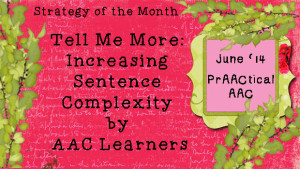
Expanding the length and complexity of sentences is something that SLPs love to work on well beyond the ‘early communicator’ phase, something we talked about a few weeks back. In today’s post, we’ll consider ways to build more complex utterances for learners who are gaining competence with their AAC systems but who still use language that is immature, imprecise, or overly simplistic. In many ways, this therapy is like language therapy for any other learner with delays in grammar, syntax, and morphology. Indeed, we sometimes forget to activate all that we know about language intervention when working learners who use AAC. We try to use that as a starting point and adjust for the AAC components as needed. Here are some of the things that we think about when planning therapy for AAC learners who are trying to strengthen their ability to speak in more complex sentences. Relate the language... [Read More...]
Filed under: Strategy of the Month
Tagged With: intervention, language intervention, sentence length, strategy
December 4, 2013
by Carole Zangari -

As clinical educators, we have lots of conversations with student SLPs about reinforcement of specific skills. We’ll save that for another post, but today we want to put reinforcement into a large context. We all learn best in an environment in which we are accepted and encouraged. It’s often hard to ‘see’ how to do that in a therapy session where the AAC learner has so many skill deficits, particularly if you are starting out in your AAC career. Here are some ideas. Accept their responses without judgment.The Dot (click on image) is a great reminder to us all of how our responses to a learner’s attempt can make ALL the difference in how they see themselves. Use the language of communication. Instead of ‘show me on your board’ or ‘point to what you want,’ use communication-oriented verbs, like ‘tell’ or ‘say.’ “Tell me what you’re thinking.” “I like what... [Read More...]
Filed under: PrAACtical Thinking
Tagged With: encouragement, intervention
November 2, 2013
by Carole Zangari -
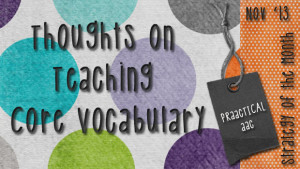
Teaching new words is something SLPs plan for in almost every service delivery setting. This month, we’ll focus on vocabulary instruction for core and extended vocabulary. Thoughts on Teaching Core Vocabulary In Advance Plan ahead. Make a rough plan of the core words you will teach and when you will introduce them to the AAC learner. Make sure there is plenty of variety, especially pronouns, verbs, prepositions, conjunctions, and determiners. Words for talking about time (e.g., now, later), asking questions (e.g., what, where), and negation (e.g., not) are important, too. Here’s a link to our post on A Year of Core and A Year of Core, Unity Style. Ensure that the AAC learner has access to communication aids with an adequate base of core vocabulary. What if the learner doesn’t have an SGD or AAC app that is core language based? If you can update that to something with good core... [Read More...]
Filed under: Strategy of the Month
Tagged With: core language, core vocabulary, intervention, semantics, vocabulary
October 29, 2013
by Carole Zangari -
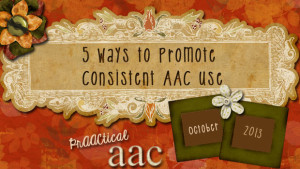
Work with someone who uses AAC but not as consistently as you would like? Here are some thoughts on how to make an impact in that area. 1. Write goals that help you fight this battle. E.g., Janie will use her AAC system to ask for help at least once per activity; Jimmy will use his AAC system to answer 2-3 curriculum-related questions in each class period; Given her AAC system, Jenny will use the correct morphological endings for plurals and past tense at the beginning or ending of each group activity. 2. Be an AAC cheerleader. In most settings, it is the adult who sets the tone for how communication will proceed. If it isn’t important to US, then it will never be important to the AAC learners. So, we try our best to use AAC every time we see the learner. It takes some work to build... [Read More...]
Filed under: PrAACtical Thinking
Tagged With: consistency, intervention, support
September 16, 2013
by Carole Zangari -

When you’re learning something new, it’s likely that you’ll need some help along the way. The same is true for our AAC learners. Here are some of the things we’ve been thinking about lately regarding prompts and cues. 1. Sometimes, actually MANY times, a ‘perfect pause’ is all that’s needed. Stop the action, look expectantly at the learner, and wait quietly. How long? It depends on the individual and the situation, but 10 or 15 seconds is in the ballpark for most AAC learners. 2. It’s important to consider both the type of prompt (e,g., gestural, verbal, physical) and how much information that prompt provides to the learner. We hear lots of SLPs say that they prefer verbal prompts because they are less helpful than, say a physical prompt, and, thus, require more from learner. Not always. Here’s an example: “Jason, tell me, ‘More milk.’” Vs. Gesturing over the message... [Read More...]
Filed under: PrAACtical Thinking
Tagged With: fading, intervention, prompt, prompt hierarchy









